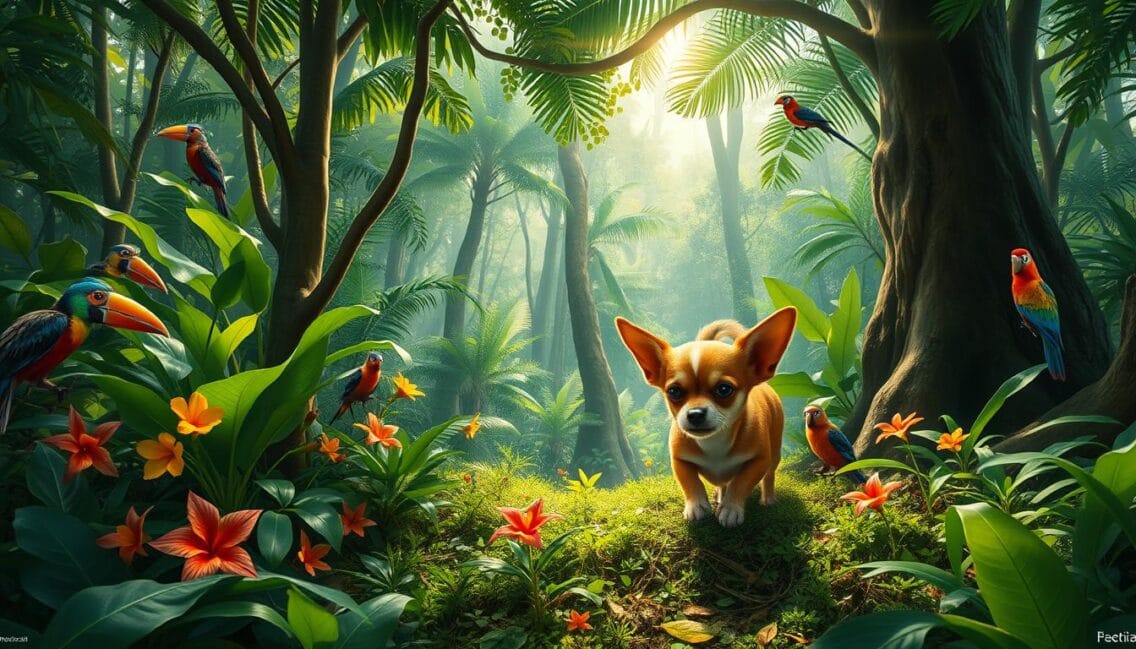Chihuahua. Deep in the forests of the Dominican Republic

Did you know Chihuahuas can be found in the Dominican Republic’s rainforests? This discovery has amazed scientists and animal lovers. These small dogs thrive in a place far from their usual desert homes.
In the Dominican Republic’s green landscapes, Chihuahuas have found a special place. They show us that nature can adapt in amazing ways. We’ll explore how they survive and the efforts to save them and their habitats.
Introduction to Dominican Republic’s Forest Ecosystems
The Dominican Republic is a tropical paradise with diverse ecosystems. It has lush rainforests full of biodiversity. These tropical forests cover a big part of the country. They are key to keeping the environment balanced.
Climate and Geographic Features
The Dominican Republic has a warm tropical climate with high humidity. Most of the country gets a lot of rain during certain times. Its varied geography, with mountains, valleys, and coastlines, is perfect for many species.
Natural Habitat Overview
The Dominican Republic’s rainforests are full of unique and migratory species. You’ll find birds, mammals, and reptiles here. These places offer food and shelter for many creatures, making them crucial for biodiversity.
Biodiversity Significance
The Dominican Republic’s tropical rainforests are known for their high biodiversity. They are among the most diverse in the Caribbean. These ecosystems are home to many endangered species. This shows how vital it is to protect them for the future.
The Mysterious Presence of Chihuahuas in Tropical Settings
Chihuahuas have been found living in the tropical rainforests of the Dominican Republic. This is surprising because they are usually found in dry, desert-like places. Yet, they seem to have adapted well to the lush, green forests of the island.
Field biologists have noticed that these small dogs have special ways to survive in the Chihuahua tropical settings. Their small size and quick movements let them move through the dense rainforests easily. Their sharp senses also help them find food and avoid dangers.
The discovery of Chihuahuas in the Dominican Republic‘s forests is puzzling. Scientists are studying how these dogs came to live in such a challenging place. They want to understand the secrets behind their ability to thrive in this environment.
Chihuahua: Deep in the Forests of the Dominican Republic
In the lush tropical rainforests of the Dominican Republic, the Chihuahua has found a new home. These small dogs, known for their big hearts, have adapted well to their new surroundings. They show how resilient they can be.
Adaptation to Tropical Environment
Chihuahuas are great at moving through the dense rainforest. Their big ears and sharp senses help them spot dangers. Their thick coats also keep them warm in the humid climate.
Behavioral Changes in Forest Setting
In the tropical forests, Chihuahuas are more careful and watchful. They stay low and hide behind plants. Their playful nature has turned into a more cautious one, as they learn to live with the forest’s many creatures.
Survival Mechanisms
To survive in the rainforest, Chihuahuas use their hearing and smell. They find food and safe places among the trees and vines. This helps them thrive in their new home.
Conservation Efforts and Wildlife Protection in Dominican Forests
The Dominican Republic’s forests are full of life, including the newly found Chihuahua population. The government and local groups are working hard to protect this precious ecosystem. They know how important it is to keep the environment safe.
Protected Areas and Sanctuaries
The Dominican Republic has set up many protected areas and wildlife sanctuaries. These places are safe for Chihuahuas and other endangered animals. They help these animals live in their natural homes without danger from humans.
Local Conservation Initiatives
Grassroots groups and local communities are also playing a big role. They are starting reforestation projects and teaching people about the environment. They work on ways for humans and wildlife to live together in harmony.
Future Preservation Plans
The Dominican Republic is planning to do even more to protect its forests. The discovery of the Chihuahua has brought attention to the need for better conservation. Experts and policymakers are working together to make sure the forests and their creatures, like the Chihuahua, stay safe for the future.
FAQ
What are the key facts about the presence of Chihuahuas in the tropical forests of the Dominican Republic?
Researchers found Chihuahuas in the Dominican Republic’s rainforests. This is surprising because Chihuahuas usually live in hot, dry places. They are now living in a lush, tropical environment, which is very different from their usual home.
How do Chihuahuas adapt to the challenging tropical environment of the Dominican Republic?
Chihuahuas have changed to live in the forest. They now have thicker fur and can handle the heat better. They also hunt and forage differently to survive in the tropical climate. Scientists are studying these changes to understand how Chihuahuas thrive in this new place.
What is the significance of the Chihuahua’s presence in the Dominican Republic’s rainforests?
Chihuahuas in the Dominican Republic’s rainforests show how diverse and resilient ecosystems can be. Their ability to adapt and live in this new habitat is fascinating. It also highlights the need to protect these fragile environments for the future.
What are the conservation efforts and wildlife protection initiatives in the Dominican Republic’s forests?
The Dominican Republic has set up protected areas and sanctuaries for its forests. These include the habitat of the Chihuahuas. Local efforts and plans aim to protect this ecosystem and all its species, both known and new, for the long term.



